TechRadar Verdict
The 55-inch Panasonic FZ802 OLED TV is all about picture quality and it delivers in spades, with the most accurate SDR and HDR images we’ve seen.
Pros
- +
Superb picture quality
- +
Impressive HDR performance
- +
Simple but effective smart platform
- +
Minimalist design and well built
Cons
- -
No Dolby Vision or Dolby Atmos support
- -
Only two full bandwidth HDMI inputs
Why you can trust TechRadar
Since all the OLED TVs on the market use panels manufactured by a single supplier, it’s the processing behind the scenes that differentiates one brand from the next. Each has its strengths and weaknesses, but no manufacturer places as much importance on image accuracy as Panasonic.
The company has a long history of providing professional monitors to the film industry, and this close relationship with Hollywood has filtered down to its consumer displays. Post-production houses use Panasonic OLED TVs as large screen monitors, which gives you an idea of how accurate they are.
The company’s latest range of OLED TVs is headlined by the FZ952, but the mid-range FZ802 is identical in terms of picture quality. The only major difference is that the cheaper model doesn’t have the built-in Technics soundbar. In all other respects the two models are the same, with Ultra HD Premium, THX and ISF certification.
The FZ802 comes in two screen sizes: 55-inch (TX-55FZ802B – £2,299, reviewed here) and 65-inch (TX-65FZ802B – £3,499). In territories outside the UK that don’t use the Freeview Play tuner, the same model is called the FZ800.
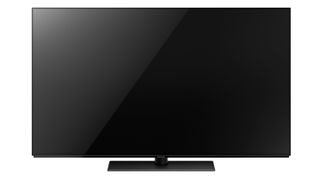
Design
Panasonic has gone for a decidedly old-school approach with the FZ802, but we like its no-frills minimalist design. This OLED TV is all about the picture, so why waste your effort trying to win a beauty parade, especially if the panel might well end up in a semi-professional environment.
What you get is a simple panel that boasts a solid black metal construction, making it surprisingly robust considering it’s only millimetres deep at the top. Things widen out at the bottom, which is where all the electronics, connections, amplification, and downward-firing speakers are housed.
There’s a dark metal trim around the outer edge, and a 10mm wide black border around the screen itself. The panel sits on a traditional metal stand with a matching black finish, that is 500mm x 300mm, which should fit comfortably on most equipment racks.
There is a removable cover over the rear of the stand, and a detachable panel over the connections, both of which allow for tidier cable management. The connections are comprised of four HDMI inputs, one of which supports ARC (Audio Return Channel). However only HDMI 1 and 2 are full bandwidth, with 3 and 4 able to support 4K/60p but with the chroma capped at 4:2:0.
There are also three USB ports (one of which you can use with an external drive for timeshiftimg TV programmes), an optical digital output, an SD card reader, a headphone socket, an Ethernet port, and built-in WiFi. Panasonic have also included an analogue audio input and a component video input, which is something of a curiosity these days.
The included remote control is a silver plastic affair that, whilst rather lightweight, includes all the buttons you’ll need to effectively control the FZ802. There are direct buttons for Netflix and Freeview Play, plus a My App button to which you can allocate one of your favourite apps.
Design TL;DR: The design may be old-school, but it’s functional, robust and very well made. There are plenty of connections including four HDMI inputs, and the simple remote gets the job done.
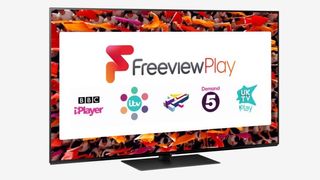
Smart TV (My Home Screen)
Panasonic’s My Home Screen smart platform is decidedly simple compared to much of the competition, but that’s not necessarily a bad thing. Currently on its third generation, it remains largely the same as the Firefox OS on which it was originally based.
When you press the Home button on the remote, you get a choice of three options: Live TV, Apps, and Devices. This simplicity is the platform’s greatest strength, making it easy to navigate and find things by helpfully storing all the apps in single location; you can also pin your favourite apps to the home page for quicker access.
Since the smart platform is relatively simple, it doesn’t require a vast amount of processing power to operate, which makes it responsive, robust, and free from crashes. My Home Screen isn’t fragmented like some platforms, nor does it bombard you with recommendations, it simply delivers all the streaming and catch-up services you need.
Thanks to Freeview Play it’s a fairly comprehensive list of catch-up services with BBC iPlayer, ITVhub, All4, My5, BBC News & Sport and UK Play. The iPlayer app supports 4K and HLG (Hybrid Log-Gamma – the broadcast version of HDR), both of which the BBC are trialing during the World Cup. There’s also Netflix, Amazon and YouTube, all of which support 4K and HDR, along with services like Rakuten and Chili Cinema. In fact the only major streaming service missing is NOW TV.
Smart TV TL;DR: Panasonic’s smart platform is simple and intuitive, containing almost all the main streaming services in a single easy to use portal.
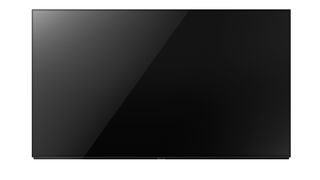
HD/SDR Performance
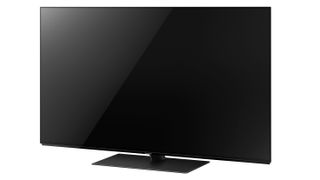
Screen Sizes: 55-, 65-inches| Tuner: Freeview Play, satellite HD | 4K: Yes | HDR: Yes | Panel technology: OLED | Smart TV: Yes, My Home Screen | Curved: No | Dimensions: 1228(w) x 713(h) x 62(d)mm | 3D: No | Inputs: 4xHDMI, 3xUSB, 2xRF, optical, analogue, headphones, CI slot
The Panasonic FZ802 delivers a superb picture right out of the box, with the kind of image accuracy rarely seen outside of a Hollywood post-production facility. The OLED defaults to the Normal picture mode, which will probably suffice for the average viewer who wants bright and colourful images.
However if you’re buying a Panasonic OLED, then the chances are you’re looking for the kind of accurate pictures that deliver the experience just as the director intended. If that’s the case then you should consider using the THX, True Cinema or ISF modes, all of which provide a highly accurate starting point.
Exactly which mode you choose will depend on factors like personal preference and the viewing environment. The more ambient light there is in the room, the brighter the picture needs to be. So you could use THX Bright Room during the day, and THX Cinema at night. Whichever approach you take, you can rest assured that the FZ802 is hitting the industry standards with exceptional precision.
The result is a stunning picture that delivers natural colours, bright highlights, and deep blacks that retain plenty of details in the shadows. Thanks to the Absolute Black filter, the dynamic range in SDR was almost as impressive as its HDR counterpart, giving images greater depth and real impact.
The detail revival is also exceptional and the FZ802 seems able to make HD broadcasts look almost 4K thanks to some seriously good image processing. This is provided by the second generation HCX processor, developed in conjunction with Hollywood colourists to ensure that their hard work is delivered exactly as they intended.
Watching a show like Humans, the Panasonic revealed so much detail that you could see the ‘synths’ make-up and contact lenses – which probably wasn’t what the filmmakers intended. Feed the FZ802 a high quality Blu-ray like Tomorrowland and the results were often breathtaking, with the kind of image accuracy that reminds you just how good 1080p can still look in these days of 4K and HDR. The Panasonic was equally as adept when it came to streaming and the new Marvel series Cloak and Dagger looked fantastic on Amazon.
The motion is also impressive, with the 24p images on movies handled particularly well. The same goes for football, with the movement of players and passing of the ball looking suitably smooth in the World Cup broadcasts. This fluid motion also applies to games, and thanks to a 22ms input lag the experience is both responsive and entertaining.
HD/SDR Performance TL;DR: This OLED TV delivers one of the most accurate pictures we’ve ever seen; choose the right setting and you can be sure you’re watching what the director intended.
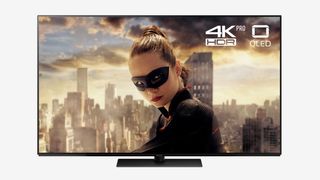
4K/HDR Performance
If we thought the SDR images looked good, nothing could have prepared us for the FZ802’s performance with 4K and HDR. The level of detail was often astonishing, allowing us to count every hair in Leonardo DiCaprio’s beard in The Revenant. If the content you’re watching is native 4K, then this TV can ensure you see every pixel.
Since it uses an OLED panel the Panasonic can’t go as bright as a competing LCD, and we measured the peak brightness at 750nits on a 10% window. The FZ802 could get closer to 900nits on smaller areas of brightness, but HDR isn’t just about brightness; it’s about the range between black and white. So it’s the incredibly deep blacks and subtle shadow details on the FZ802 that give HDR images real impact.
The FZ802 supports standard HDR10, as well as broadcast HLG, which we were able to test thanks to the BBC’s trial streaming of matches in 4K from the World Cup. The Panasonic also supports HDR10+ but as far as we know that feature hasn’t been added yet. The only source of HDR10+ content is currently Amazon; unfortunately there’s no way to identify whether content is being decoded with HDR10+, so we weren’t able to effectively test it.
We should point out that the Panasonic doesn’t support Dolby Vision. How important that is remains to be seen but as things currently stand, there is significantly more Dolby Vision content than there is HDR10+ content. The benefits of HDR10+ and Dolby Vision, both of which use dynamic metadata, are fairly minimal. But what is important is how well a display handles regular HDR10: in this regard the FZ802 didn’t disappoint.
It accurately tone maps HDR10 content, taking the original signal and matching it to the capabilities of the OLED panel using the correct PQ curve. However this approach can lead to some images appearing too dark, so Panasonic has added Dynamic LUTs (look-up tables) to the HCX processor.
The Dynamic Scene Optimiser feature analyses the image and adjusts the tone mapping on the fly, to deliver an HDR image that is more consistent from scene to scene. There’s also the Auto Brightness Enhancer, which optimises the brightness depending on the ambient light in your viewing environment.
The use of 3D LUTs also means that the FZ802 can deliver colours with absolute fidelity, and the Panasonic tracked the DCI-P3 colour space very accurately. The result was a beautifully-nuanced HDR performance that delivered all the benefits that the format has to offer.
The space shots in a film like Passengers are inky black, but retain subtly detailed shadows that takes full advantage of the increased dynamic range in the darker parts of the picture. Conversely the specular highlights are delivered with pixel precision, and absolutely no sign of clipping or a loss in detail.
The colour performance was simply breathtaking, with the wider gamut offered by HDR meaning that colours appeared more saturated and thus more realistic. There was a richness to the picture that enhanced every aspect of the viewing experience, and revealed just how important image fidelity is when it comes to HDR.
4K/HDR Performance TL;DR: Panasonic’s uncompromising approach to HDR fidelity pays real dividends on the FZ802, but the Dynamic Scene Optimiser is a great new feature as well.
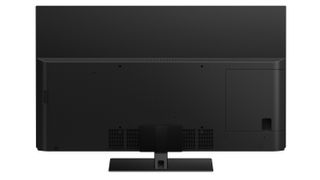
Sound
The FZ802 doesn’t have the Dynamic Blade soundbar tuned by Technics that graces the more expensive FZ952, but it still sounds surprisingly good for a modern slimline OLED TV. Panasonic certainly hasn’t skimped when it comes to the speakers and amplification, with four drivers built-in and a total of 40W of power. The solid metal construction of the TV itself also helps, and the resulting mid-range is solid, with nicely defined higher frequencies. There’s even a degree of bass to the audio and you can push the Panasonic quite loud without it sounding shrill or brittle.
Unlike competitors such as LG, Panasonic doesn’t support Dolby Atmos so you can’t benefit from a more immersive audio experience. However the direct stereo nature of the FZ802 means it is still capable of producing an open front soundstage. If you want big, room-filling sound then you should really look at a separate soundbar, or perhaps consider buying the FZ952. However for day-to-day use, the sound quality on the FZ802 is more than adequate.
Sound TL;DR: The sound quality is surprisingly good for a slimline OLED TV, but if audio is important you might want to check out the FZ952 with its Technics-tuned soundbar.
Other panels to ponder…
The FZ802 delivers exceptional value in what is a fairly crowded market place. The Sony AF8 is certainly a possible alternative, it costs slightly more but includes Acoustic Surface audio and support for Dolby Vision, although the Android smart platform is something of an acquired taste.
A better alternative is the LG C8 OLED, which is also more expensive but offers the most complete package of any OLED TV this year. It has a superb picture, a gorgeous design, an exceptional smart platform that includes every major streaming service, and it even sounds good. Once you throw in support for every HDR format except HDR10+, and even Dolby Atmos, you begin to realise why it’s the OLED TV to beat in 2018.
Verdict
The FZ802 does exactly what it was designed to do, deliver exceptionally accurate pictures at a competitive price. The Panasonic is cheaper than its main competitors, but is still well-made and boasts a smart platform that is simple but highly effective. The TV also produces the best SDR and HDR images that we have seen out of an OLED to date, thanks largely to highly sophisticated picture processing.
It’s not the compete package, lacking the Dolby Vision and Dolby Atmos support found on LG’s OLEDs, but it does include HDR10+. The sound quality is reasonably good for a modern slimline TV, although if that’s a factor you might want to check out Panasonic’s FZ952 with its Technics-tuned soundbar.
Panasonic has made a big deal out of its association with Hollywood studios, and the FZ802 bears the fruits of that relationship with pictures that truly are what the director intended.
- Expect to see the FZ802 on our list of the best OLED TVs

